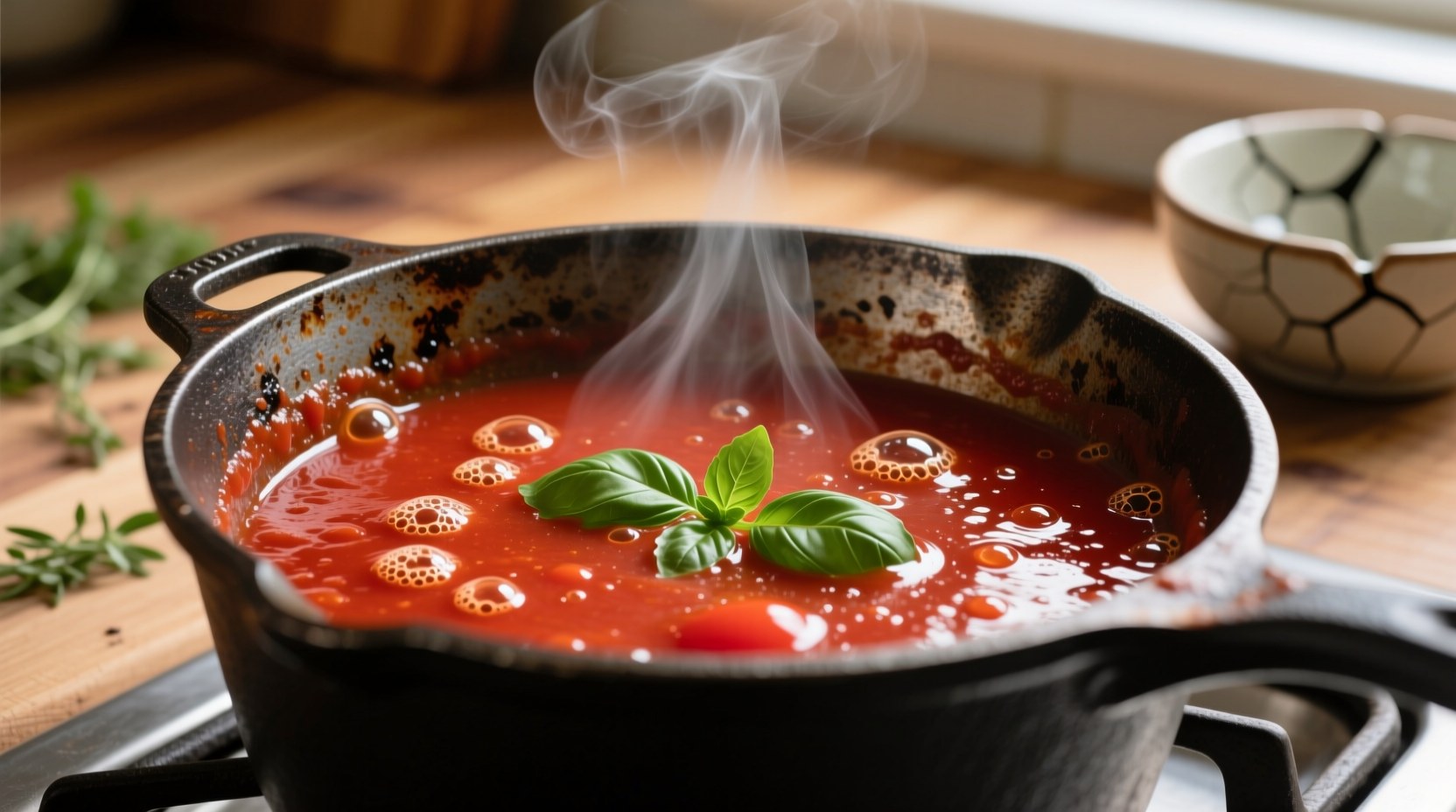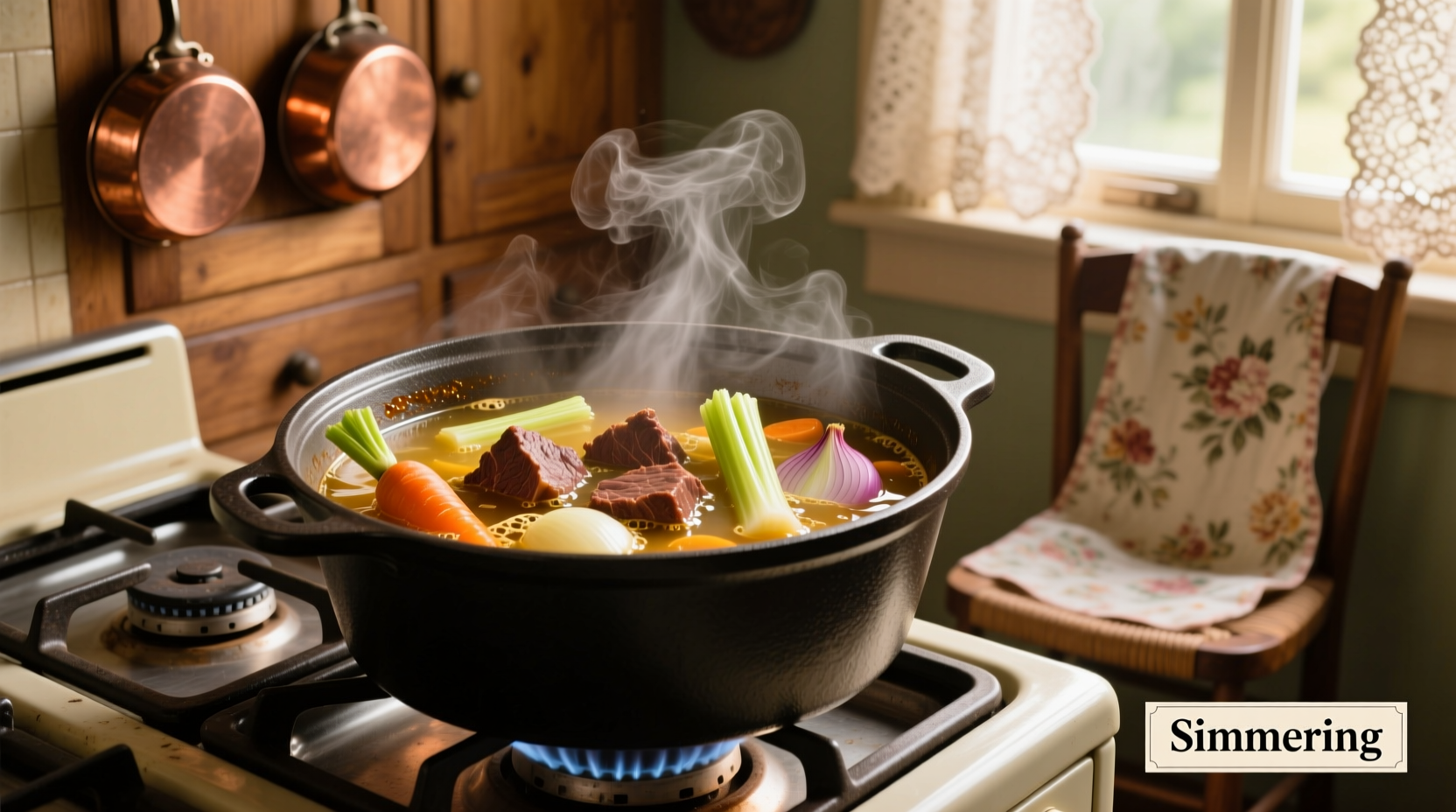Mastering simmering transforms ordinary dishes into culinary masterpieces. Whether you're preparing a delicate French consommé or hearty Italian ragù, understanding this fundamental technique gives you precise control over texture, flavor development, and ingredient integrity. In this comprehensive guide, you'll learn not just what simmering is, but how to recognize it perfectly, when to apply it, and why professional chefs consider it essential for exceptional cooking results.
Understanding Simmering: Beyond Basic Definition
Simmering sits precisely between poaching (160-180°F) and boiling (212°F) on the cooking temperature spectrum. This sweet spot creates ideal conditions for complex flavor development without damaging delicate ingredients. When properly executed, you'll observe small bubbles occasionally breaking the surface, with steam gently rising but without the violent agitation of boiling.
The science behind simmering reveals why it's so crucial: at these temperatures, proteins coagulate slowly rather than seizing up, connective tissues break down gradually without becoming tough, and starches swell properly without rupturing. This controlled environment allows for optimal flavor extraction and melding.

Simmering vs. Boiling: Critical Differences
| Characteristic | Simmering | Boiling |
|---|---|---|
| Temperature Range | 180-205°F (82-96°C) | 212°F (100°C) |
| Bubble Activity | Small bubbles occasionally rising | Vigorous, constant bubbling |
| Surface Movement | Gentle movement, slight shimmer | Rolled, turbulent surface |
| Best For | Stocks, stews, sauces, delicate proteins | Pasta, vegetables, sterilization |
| Flavor Development | Gradual melding, complex layers | Rapid extraction, potential bitterness |
Why Simmering Matters for Flavor Development
According to culinary research published by the Culinary Institute of America, simmering allows for optimal flavor extraction from ingredients without driving away volatile aromatic compounds that occur at higher temperatures. This explains why a properly simmered stock has more nuanced flavor than one boiled rapidly.
When creating reductions, simmering provides controlled evaporation that concentrates flavors while maintaining balance. Boiling would cause too-rapid reduction, potentially creating an unbalanced, overly concentrated product. The gentle movement during simmering also helps distribute flavors evenly throughout the liquid.
Practical Guide to Perfect Simmering Technique
Equipment Considerations
While you can simmer in any pot, heavy-bottomed cookware like cast iron or stainless steel with an aluminum core provides the most even heat distribution. This prevents hot spots that can cause localized boiling while other areas remain too cool. A heavy lid helps maintain consistent temperature by trapping steam.
Heat Control Methods
True simmering requires careful heat management. Start by bringing your liquid to a boil, then immediately reduce heat to maintain that delicate bubble activity. On most stovetops, this means using medium-low to low heat. For precise control, consider using a simmer mat or diffuser plate, especially with electric burners that maintain higher minimum temperatures.
Lid Position Guidance
Lid position significantly affects simmering:
- Full simmer (covered): For dishes needing maximum heat retention like tough cuts of meat
- Partial simmer (lid slightly ajar): For maintaining temperature while allowing some evaporation
- Uncovered simmer: For reductions where you want liquid to evaporate
Timing Considerations
Different ingredients require varying simmer times:
- Stocks and broths: 4-6 hours for optimal collagen extraction without cloudiness
- Tough meat cuts: 2-3 hours for proper connective tissue breakdown
- Sauces and reductions: Until desired consistency is reached, typically 20-60 minutes
- Dairy-based sauces: Never boil; maintain gentle simmer to prevent curdling
Common Simmering Mistakes to Avoid
Even experienced cooks make these critical errors:
- Confusing simmering with boiling: Many recipes call for simmering but cooks maintain a rolling boil, damaging delicate ingredients
- Over-stirring: Excessive stirring can break down ingredients that should maintain texture
- Incorrect pot size: Too-small pots cause liquid to boil over; too-large pots create uneven heating
- Adding cold ingredients to hot liquid: Causes temperature fluctuations that disrupt the simmer
Advanced Simmering Applications
Professional chefs use nuanced simmering techniques that elevate everyday cooking:
Temperature Zoning
Some chefs create temperature gradients within their simmering liquid. By positioning ingredients strategically in the pot, they can cook different components at slightly different temperatures. For example, placing vegetables higher in the pot (where liquid is slightly cooler) while keeping meats submerged in the hotter lower portion.
Flavor Layering Through Simmering
Mastering the sequence of ingredient addition during simmering creates complex flavor profiles. Start with aromatics (onions, garlic, celery), then add tougher vegetables, followed by proteins, and finally delicate herbs at the end. This layering technique prevents delicate flavors from being cooked out while ensuring tougher ingredients have enough time to develop flavor.
Simmering in Different Culinary Traditions
Culinary traditions worldwide have perfected simmering techniques:
- French cuisine: Consommé requires crystal-clear broth achieved through careful simmering with egg whites
- Italian ragù: Traditional recipes call for 4-6 hours of gentle simmering for optimal texture
- Chinese braising: Master stocks are maintained for generations with continuous gentle simmering
- Mexican moles: Complex sauces require hours of simmering to meld dozens of ingredients
Troubleshooting Common Simmering Issues
When your simmer isn't behaving as expected, these solutions can help:
- Simmer too vigorous: Reduce heat immediately and consider moving pot to cooler burner position
- Liquid evaporating too quickly: Partially cover with lid or reduce heat slightly
- Inconsistent simmer: Use heavy-bottomed cookware and ensure burner size matches pot diameter
- Cloudy stock: Start with cold water and maintain gentle simmer; avoid boiling which emulsifies fat
When Simmering Isn't the Right Technique
Not all dishes benefit from simmering. Understanding when not to simmer is equally important:
- Fresh herbs: Add at the very end to preserve volatile oils
- Delicate fish: Often better poached at lower temperatures
- Certain vegetables: Broccoli and asparagus lose texture and nutrients with prolonged simmering
- Dairy-based sauces: Should never reach simmering point to prevent curdling
Essential Tools for Perfect Simmering
While you don't need specialized equipment, these tools make achieving perfect simmer easier:
- Digital thermometer for precise temperature monitoring
- Heavy-bottomed Dutch oven for even heat distribution
- Simmer mat or diffuser for electric stovetops
- Timer to track simmering duration accurately
- Wooden spoon for gentle stirring without scratching cookware
Frequently Asked Questions
How can I tell if my liquid is simmering properly without a thermometer?
Watch for small bubbles rising steadily from the bottom but not breaking the surface rapidly. You should see occasional bubbles breaking the surface, with steam rising gently but not vigorously. The liquid should have a slight shimmer but no rolling motion. If you hear a gentle bubbling sound but not a rolling boil sound, you've achieved proper simmering.
Can I simmer on an electric stove effectively?
Yes, but electric stoves require more attention as they maintain heat longer after adjustment. Start with medium heat, bring to boil, then reduce to the lowest setting. Consider using a simmer mat or diffuser plate to moderate heat. You may need to turn the burner off periodically and let residual heat maintain the simmer, especially for long cooking times.
Why does my sauce sometimes break when simmering?
Sauces break when emulsions separate, often due to excessive heat, over-stirring, or adding ingredients too quickly. For dairy-based sauces, never let them reach a full simmer. Maintain gentle heat below 180°F and add dairy gradually while stirring constantly. For oil-based emulsions like vinaigrettes, ensure proper ratio of oil to acid and add oil slowly while whisking vigorously.
How long can I safely simmer food on the stove?
Most dishes can simmer safely for 4-6 hours. For longer periods (like traditional stocks), ensure liquid doesn't reduce below covering ingredients. The USDA Food Safety and Inspection Service recommends not leaving food in the temperature danger zone (40°F-140°F) for more than 2 hours. Since simmering maintains temperatures well above 140°F, it's safe for extended periods as long as liquid levels are maintained.
Does simmering destroy nutrients in food?
Compared to boiling, simmering preserves more nutrients because lower temperatures cause less nutrient leaching into the cooking liquid. Water-soluble vitamins like vitamin C and B vitamins are better retained with gentle simmering than rapid boiling. Additionally, since simmering often involves shorter cooking times for vegetables than boiling, more nutrients remain intact. The key is not to overcook ingredients beyond what's necessary for the dish.











 浙公网安备
33010002000092号
浙公网安备
33010002000092号 浙B2-20120091-4
浙B2-20120091-4